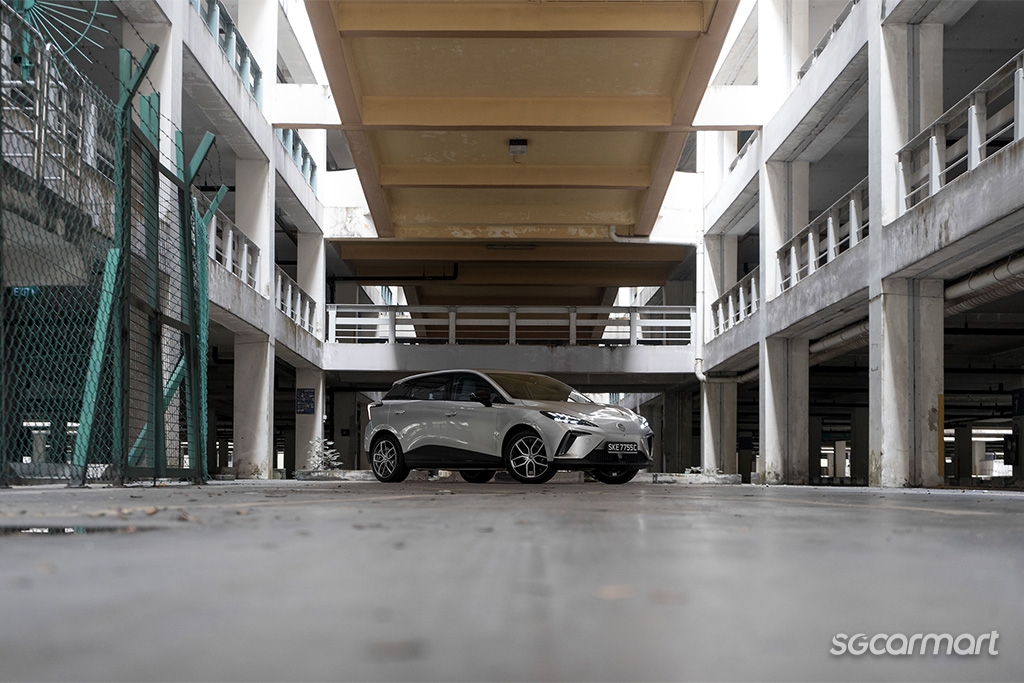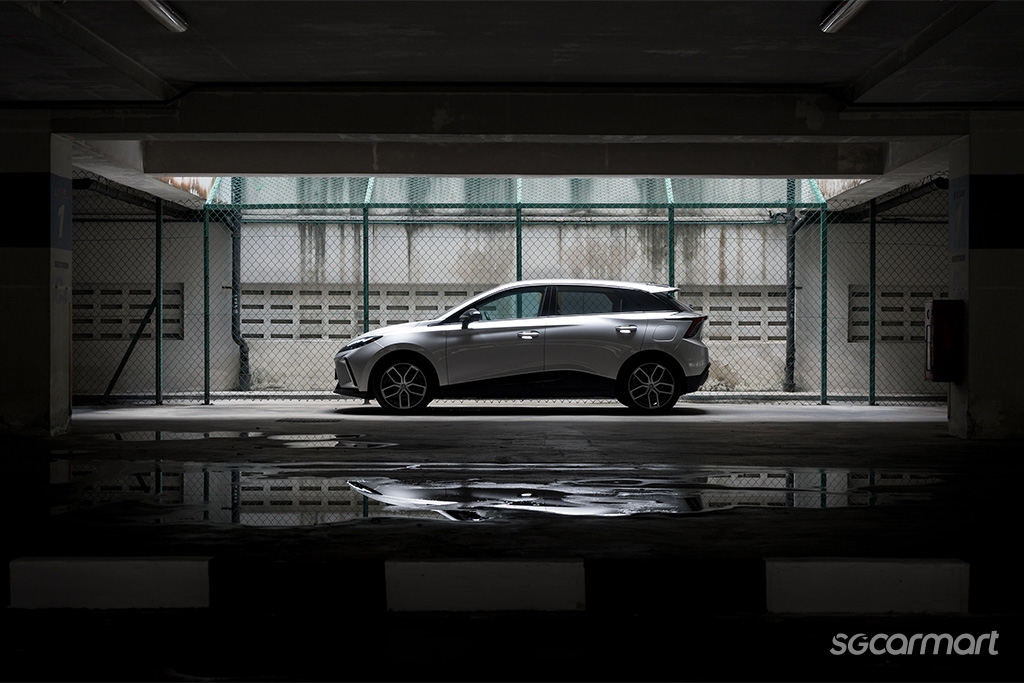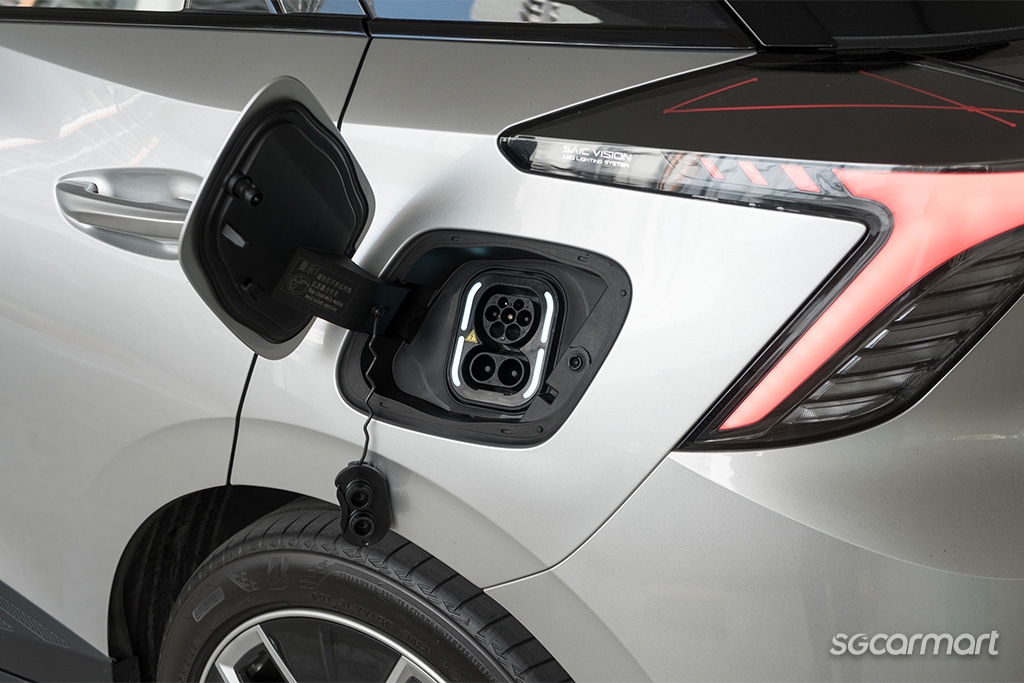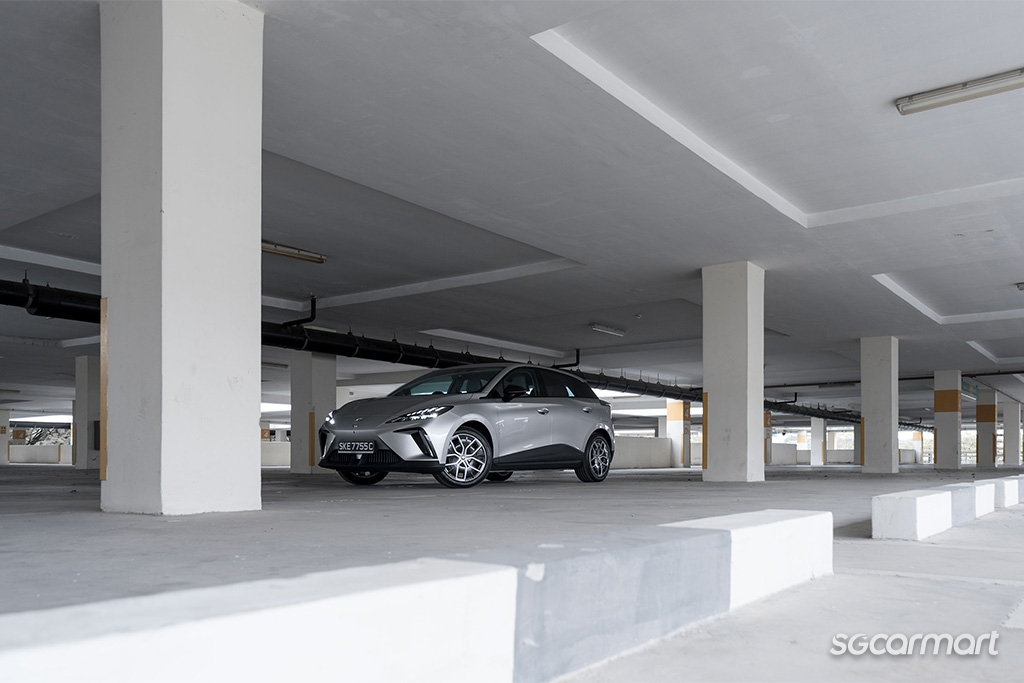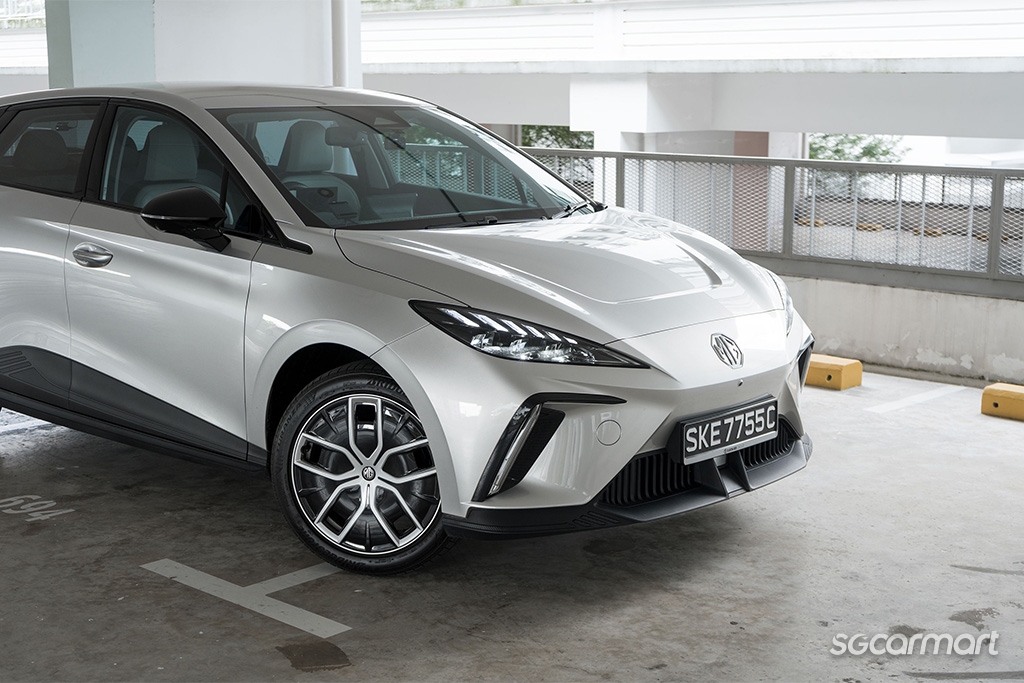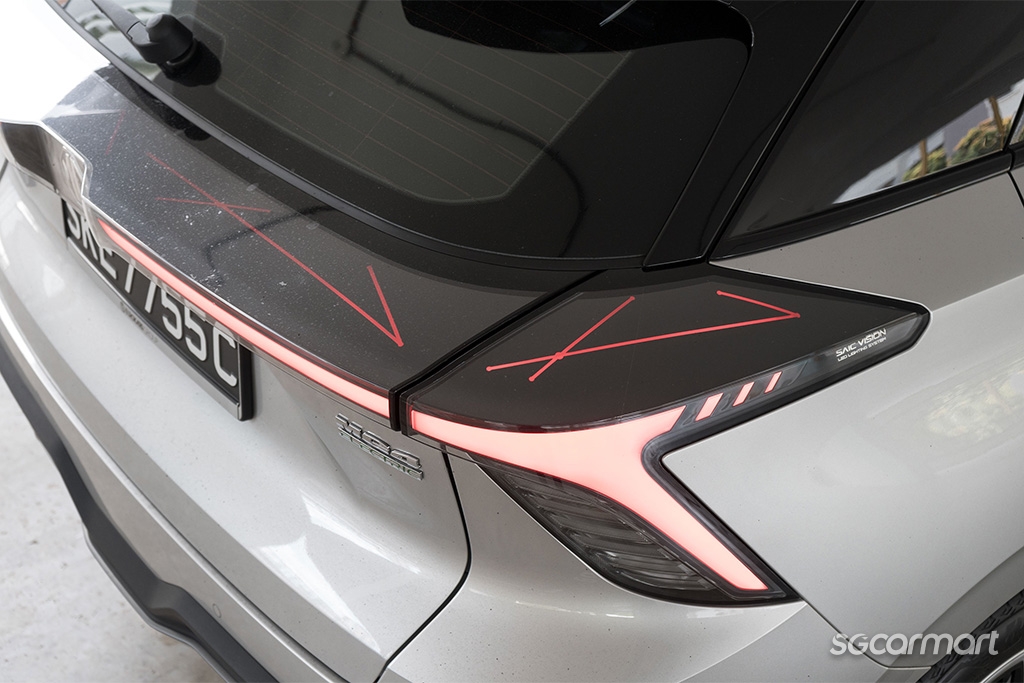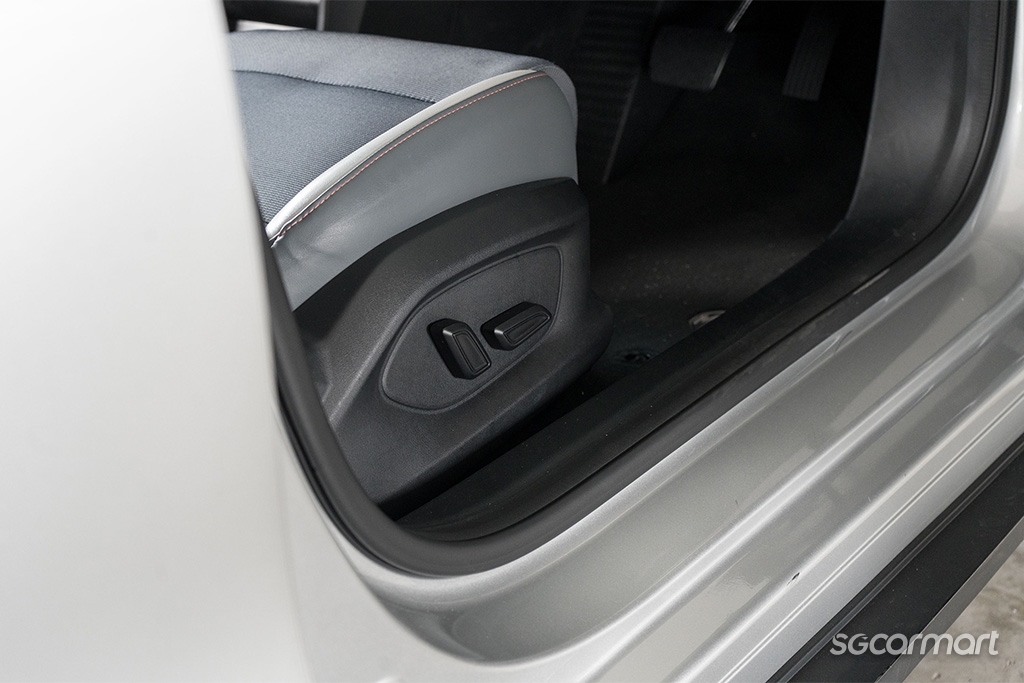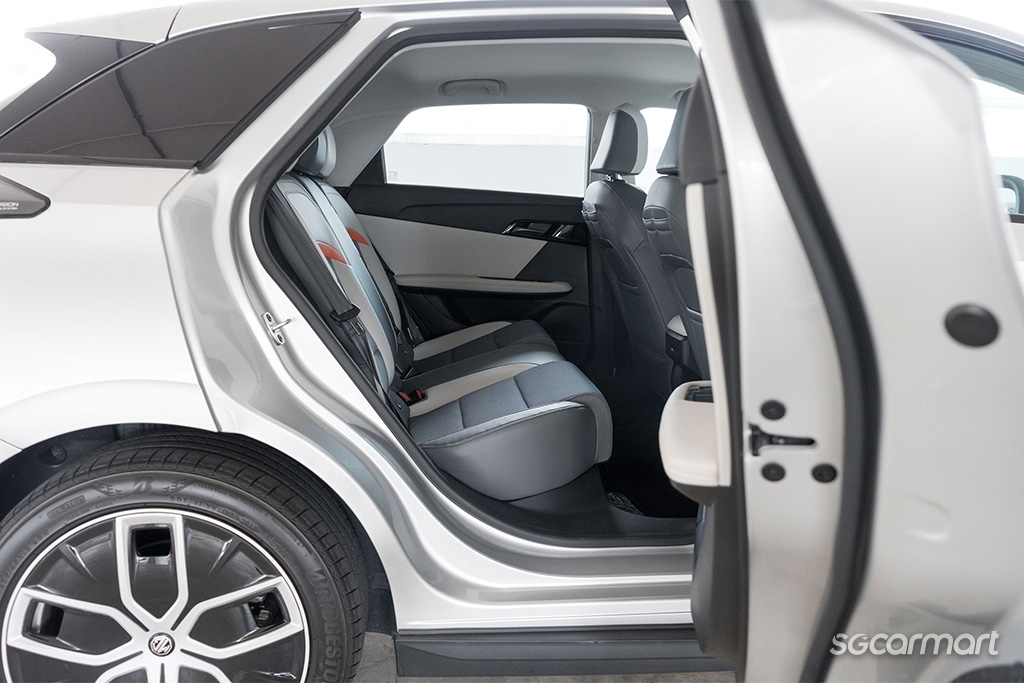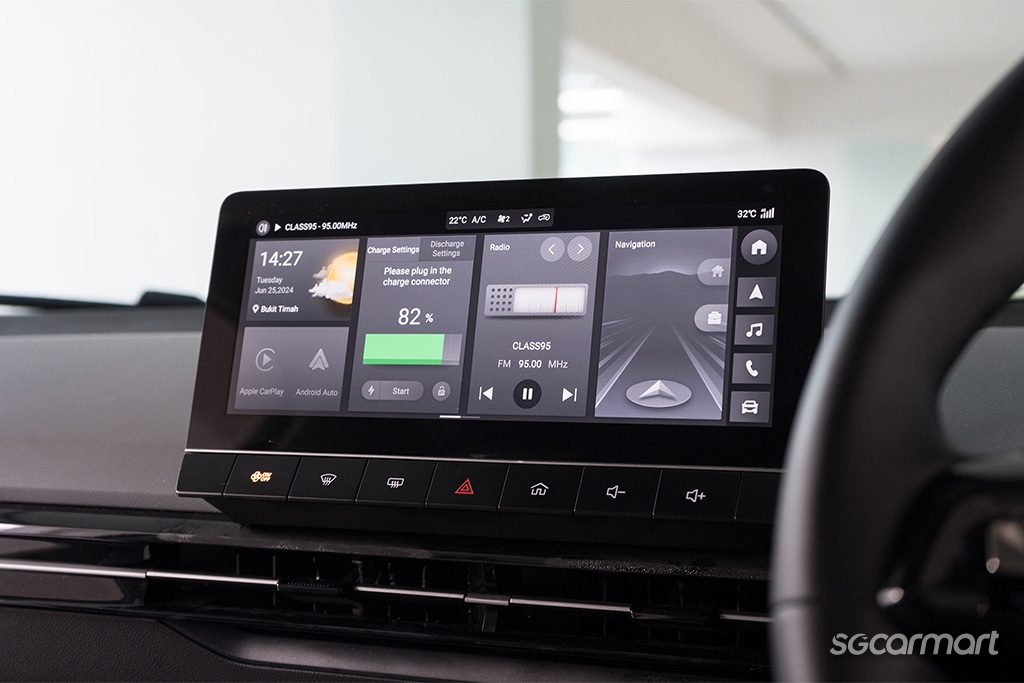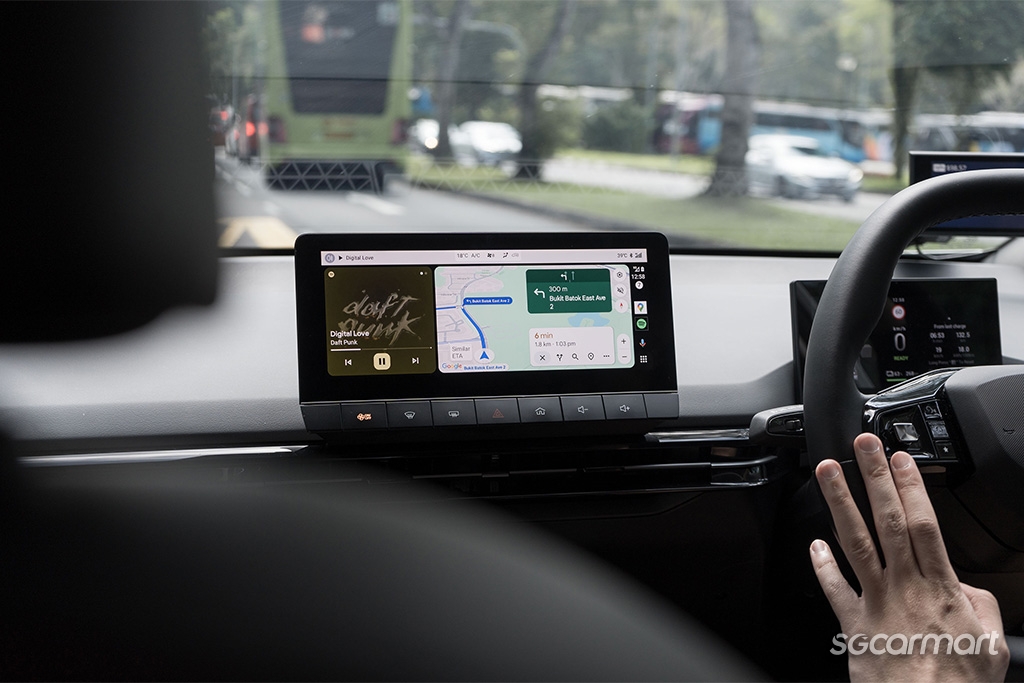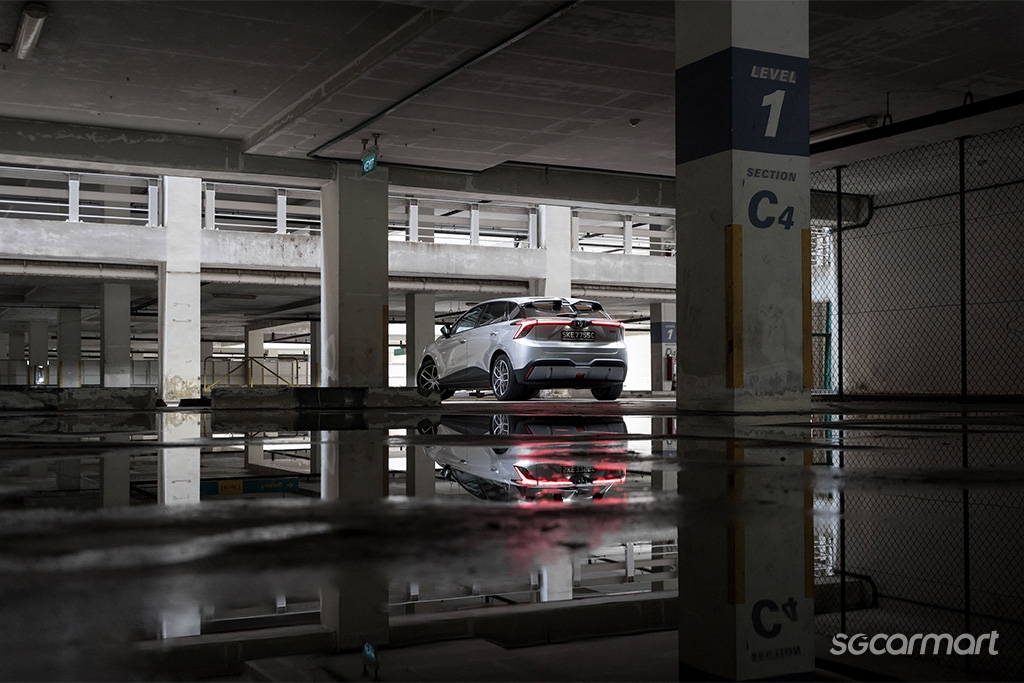MG 4 EV 99kW 64kWh Review
02 Jul 2024|13,198 views
What We Like
Power cut hard to detect from behind the wheel
Continues to be one of the sweetest EVs to drive currently
Styling still as head-turning as when the car was first introduced
Decently spacious and practical for its size
What We Dislike
Laggy infotainment system
Cheap-feeling plastics in some parts of the cabin
Too much power is never a bad thing… unless you're a compact, mass-market oriented car in Singapore, aiming to help your parent brand gain a firmer foothold in the market.
The MG 4 EV is - or was - one of those cars.
Everything about the hatch spelled out 'Bold New Chapter' for MG: Head-turning styling, a bespoke electric platform, and - rather surprisingly - driving characteristics that skewed more German than Anglo-Chinese.
Except that with a 150kW (201bhp) motor powering the car when it was first introduced to us, the MG 4 EV was catapulted towards heights it (probably) didn't want to reach: Into Category B. Timing is always key to a car launch, and when we first drove the car in March 2023, the gap in premiums between Cat A and B was trending at close to $30,000. That's quite a fair bit of money to the average family-car shopper.
Thankfully, that's not where the story ends. Instead, it continues now with a blink-and-you'll-miss-it tweak introduced at the start of 2024 - which has arguably elevated the car's prospects again: Less power.
As mentioned, the MG 4 EV was first launched in Singapore with a 150kW (201bhp) electric motor mounted on its rear axle. That, however, has been tweaked so that it now produces a maximum of 99kW (133bhp) instead, which represents a power drop of 68bhp.
It also represents a ticket of eligibility for a Cat A COE.
To be clear, shaving off what is effectively a turbocharged kei car's worth of power is not insignificant. But alas, the magic of electrification means that its single motor still churns out just as much instant torque as before: A full 250Nm's worth, to be precise. While the car now takes a bit longer to zip from 0 to 100km/h, 8.5 seconds isn't slow by any measure anyway.
Again, what ultimately matters is how the car feels on the road. And on this front, the MG 4 EV continues to sparkle.
Family hatches that so clearly want to reward the driver are rare; in the fully electric realm, where driver engagement takes a backseat to comfort and refinement, these are even rarer.
Yet the MG 4 EV is still keen to fill that niche.
For starters, the dip in power is unlikely to be palpable since the car continues to be able to dart off the line. Highway merges are effortless, and road hogs are supplanted with ease.
But more crucial (and surprising) is the way the car handles. Rear-wheel drive, a low centre of gravity and 50:50 weight distribution between the front and rear axles are characteristics you would have expected from a driver-focussed executive sedan in the past - but these are all present in the MG 4 EV.
Just as importantly, these are clearly not just boxes that have been ticked off on paper by the engineering team, but tangible qualities that bear weight on how the car behaves. Its suspension tuning, while pliant enough to preserve the comfort of passengers, is a touch on the firmer side against the competition. And while the steering feel is light, it's also sharp. Here, the laws of physics work in the car's favour too, giving it a sense of sure-footedness; and the driver, confidence to throw it around.
At a time when most EVs are tipping the scales at close to (or even above!) two tonnes, the MG 4 EV also keeps things relatively lean, at just under 1.7 tonnes. You don't feel the car diving as much as you would in many other modern EVs when you want it to shed speed. On this note, even its regenerative braking system is easy to wrap your head foot around.
The combined result is a sense of glee as one prods the car off the line and around bends with relentless effortlessness; relishing all the joys of (measured) electrification, without the less confidence-inspiring aspects (heft, uninspiring handling) felt on many of its peers. It's hard to imagine the average Singaporean driver brooding over - or even remembering - the fact that a less powerful motor resides on the car's rear axle in most daily driving scenarios.
Notably, MG hasn't reduced the car's battery size with the update too, meaning the MG 4 EV continues to be powered by a 64kWh battery that can provide close to 400km on a full charge. Driving mostly on smaller roads, we were averaging between 5.6km/kWh to 5.8km/kWh - not too far off the claimed consumption figure of 5.9km/kWh.
The same head-turning qualities - with the same caveat
Furthermore, the power diet placed on the MG 4 EV invites you to take a second look at what it had already offered to begin with - which has been virtually unchanged.
This remains one of the most unusual-looking cars on our roads today, with its angry, X-shaped front end, rising beltline, and aero twin-spoilers at the rear (resembling a pair of... cat's ears?). Interestingly, the 99kW variant actually rides on larger 18-inch wheels (and different tyres too), compared to the 17-inch ones on the original 150kW variant. This update has also gifted the car a rear windscreen wiper at last.
But we digress - it's not as if the car's overall visual outlook has changed, after all.
An angry, X-shaped front end, and one of the most dramatically protruding taillight bars: The MG 4 EV is still a head-turner, more than one year after its launch on our shores
Even after driving it for a few days, the sight of how dramatically that taillight bar protrudes out - with its criss-crossing light signatures - still doesn't get old. It feels so surreal that such a bold design cue has made it to production - that you have to resist the urge to cup your hand around it every time you see it, just to be certain that it's actually there. Sensibility should reign in a family hatch - and it does in many ways here - but the MG 4 EV proves that school or grocery runs can be, dare we say, a bit flashy too.
Speaking of sensibility, the MG 4 EV is unchanged in its generosity in terms of both space and equipment.
The front seats both boast powered adjustment, while the car's tailgate similarly opens on its own with the touch of a button. All the modern safety assistance systems a driver would want are also present because the car is loaded with MG Pilot.
Not just generous in space but equipment: The car's long wheelbase gives it a spacious rear bench, while a healthy list of features includes powered seats and a powered tailgate
Built atop of that dedicated electric platform, the MG 4 EV's wheelbase is also fairly long - at 2,705mm - despite measuring just under 4.3 metres in length. Coupled with a completely flat floor, the result is a remarkably spacious rear bench. Before one bemoans the lack of rear air vents, we'd quickly counter that this isn't really an issue. One of the car's highlights continues to be its frosty air-conditioning system, which was of great comfort on a sunny day out traversing the western part of Singapore.
Still, in the same way that the MG 4 EV holds resolutely onto its old strengths, so too is it unable to shake off its single-most noteworthy flaw.
To be clear, it's not that the car's cabin doesn't feel modern. There are pleasant elements here, such as the floating centre console up front, as well as sufficient digitalisation in the form of a 7.0-inch driver's display and 10.25-inch central touchscreen. Our test unit this time was even decked out in the less austere 'Cream Grey with Orange Stitching' interior trim; its pop of colour helping to lighten the space up immediately without taking things too far into gaudiness.
Despite the use of sensible tiles and vibrant graphics, the infotainment system's prone to lag remains one of our biggest bugbears with the car
It is, nonetheless, in the actual operation of the car's infotainment system where some frustration will inevitably arise. While the graphics of its central touchscreen are fine - ditto for the way icons and tiles are labelled and laid out - the lag in loading sub-menus is hard to miss, even for more patient personality types.
Arguably, this shouldn't be - and isn't - a dealbreaker; many native infotainment systems from rival brands aren't the most sophisticated either. Most drivers are likely to project their smartphones anyway, since the MG 4 EV handily supports wired Apple CarPlay and Android Auto.
But here's where another issue emerged: The screen refused to allow us to dive straight into the air-conditioning controls when Android Auto was connected, instead forcing us back into the native system, before adjustments could be made. As a blemish, it's not small - yet also not world-shaking by any measure; just a slight pity considering everything else the MG 4 EV already does so well.
Lifting the veil of inaccessibility
Illumination can occur with the simple flick of a switch. In the case of MG 4 EV, there is no doubt that the singular act of docking power has helped lift the veil of inaccessibility once shrouding it - and as such, also instantly made it more alluring.
Rather counterintuitively, it is the driver's experience that often takes a backseat with mass-market electrification. With this power tweak now inviting buyers to take a second look at the MG 4 EV, one will find that a suitably modern do-it-all family car has always laid at the heart of its aggressive exterior. Except that apart from just blending seamlessly into today's automotive landscape, this particular hatch does so with an unexpected driver-centricity.
Sure - the MG 4 EV might still be a little rough around the edges (and not just in terms of styling). But despite its name, it also resists being your typical paint-by-numbers EV, instead holding up a template - perhaps unwittingly - for a new sort of accessible family car. It's hard to imagine this could have happened without the power cut.
Here are a couple of other electric hatchbacks in Category A that may interest you!
What We Like
Power cut hard to detect from behind the wheel
Continues to be one of the sweetest EVs to drive currently
Styling still as head-turning as when the car was first introduced
Decently spacious and practical for its size
What We Dislike
Laggy infotainment system
Cheap-feeling plastics in some parts of the cabin
Too much power is never a bad thing… unless you're a compact, mass-market oriented car in Singapore, aiming to help your parent brand gain a firmer foothold in the market.
The MG 4 EV is - or was - one of those cars.
Everything about the hatch spelled out 'Bold New Chapter' for MG: Head-turning styling, a bespoke electric platform, and - rather surprisingly - driving characteristics that skewed more German than Anglo-Chinese.
Except that with a 150kW (201bhp) motor powering the car when it was first introduced to us, the MG 4 EV was catapulted towards heights it (probably) didn't want to reach: Into Category B. Timing is always key to a car launch, and when we first drove the car in March 2023, the gap in premiums between Cat A and B was trending at close to $30,000. That's quite a fair bit of money to the average family-car shopper.
Thankfully, that's not where the story ends. Instead, it continues now with a blink-and-you'll-miss-it tweak introduced at the start of 2024 - which has arguably elevated the car's prospects again: Less power.
As mentioned, the MG 4 EV was first launched in Singapore with a 150kW (201bhp) electric motor mounted on its rear axle. That, however, has been tweaked so that it now produces a maximum of 99kW (133bhp) instead, which represents a power drop of 68bhp.
It also represents a ticket of eligibility for a Cat A COE.
To be clear, shaving off what is effectively a turbocharged kei car's worth of power is not insignificant. But alas, the magic of electrification means that its single motor still churns out just as much instant torque as before: A full 250Nm's worth, to be precise. While the car now takes a bit longer to zip from 0 to 100km/h, 8.5 seconds isn't slow by any measure anyway.
Again, what ultimately matters is how the car feels on the road. And on this front, the MG 4 EV continues to sparkle.
Family hatches that so clearly want to reward the driver are rare; in the fully electric realm, where driver engagement takes a backseat to comfort and refinement, these are even rarer.
Yet the MG 4 EV is still keen to fill that niche.
For starters, the dip in power is unlikely to be palpable since the car continues to be able to dart off the line. Highway merges are effortless, and road hogs are supplanted with ease.
But more crucial (and surprising) is the way the car handles. Rear-wheel drive, a low centre of gravity and 50:50 weight distribution between the front and rear axles are characteristics you would have expected from a driver-focussed executive sedan in the past - but these are all present in the MG 4 EV.
Just as importantly, these are clearly not just boxes that have been ticked off on paper by the engineering team, but tangible qualities that bear weight on how the car behaves. Its suspension tuning, while pliant enough to preserve the comfort of passengers, is a touch on the firmer side against the competition. And while the steering feel is light, it's also sharp. Here, the laws of physics work in the car's favour too, giving it a sense of sure-footedness; and the driver, confidence to throw it around.
At a time when most EVs are tipping the scales at close to (or even above!) two tonnes, the MG 4 EV also keeps things relatively lean, at just under 1.7 tonnes. You don't feel the car diving as much as you would in many other modern EVs when you want it to shed speed. On this note, even its regenerative braking system is easy to wrap your head foot around.
The combined result is a sense of glee as one prods the car off the line and around bends with relentless effortlessness; relishing all the joys of (measured) electrification, without the less confidence-inspiring aspects (heft, uninspiring handling) felt on many of its peers. It's hard to imagine the average Singaporean driver brooding over - or even remembering - the fact that a less powerful motor resides on the car's rear axle in most daily driving scenarios.
Notably, MG hasn't reduced the car's battery size with the update too, meaning the MG 4 EV continues to be powered by a 64kWh battery that can provide close to 400km on a full charge. Driving mostly on smaller roads, we were averaging between 5.6km/kWh to 5.8km/kWh - not too far off the claimed consumption figure of 5.9km/kWh.
The same head-turning qualities - with the same caveat
Furthermore, the power diet placed on the MG 4 EV invites you to take a second look at what it had already offered to begin with - which has been virtually unchanged.
This remains one of the most unusual-looking cars on our roads today, with its angry, X-shaped front end, rising beltline, and aero twin-spoilers at the rear (resembling a pair of... cat's ears?). Interestingly, the 99kW variant actually rides on larger 18-inch wheels (and different tyres too), compared to the 17-inch ones on the original 150kW variant. This update has also gifted the car a rear windscreen wiper at last.
But we digress - it's not as if the car's overall visual outlook has changed, after all.
An angry, X-shaped front end, and one of the most dramatically protruding taillight bars: The MG 4 EV is still a head-turner, more than one year after its launch on our shores
Even after driving it for a few days, the sight of how dramatically that taillight bar protrudes out - with its criss-crossing light signatures - still doesn't get old. It feels so surreal that such a bold design cue has made it to production - that you have to resist the urge to cup your hand around it every time you see it, just to be certain that it's actually there. Sensibility should reign in a family hatch - and it does in many ways here - but the MG 4 EV proves that school or grocery runs can be, dare we say, a bit flashy too.
Speaking of sensibility, the MG 4 EV is unchanged in its generosity in terms of both space and equipment.
The front seats both boast powered adjustment, while the car's tailgate similarly opens on its own with the touch of a button. All the modern safety assistance systems a driver would want are also present because the car is loaded with MG Pilot.
Not just generous in space but equipment: The car's long wheelbase gives it a spacious rear bench, while a healthy list of features includes powered seats and a powered tailgate
Built atop of that dedicated electric platform, the MG 4 EV's wheelbase is also fairly long - at 2,705mm - despite measuring just under 4.3 metres in length. Coupled with a completely flat floor, the result is a remarkably spacious rear bench. Before one bemoans the lack of rear air vents, we'd quickly counter that this isn't really an issue. One of the car's highlights continues to be its frosty air-conditioning system, which was of great comfort on a sunny day out traversing the western part of Singapore.
Still, in the same way that the MG 4 EV holds resolutely onto its old strengths, so too is it unable to shake off its single-most noteworthy flaw.
To be clear, it's not that the car's cabin doesn't feel modern. There are pleasant elements here, such as the floating centre console up front, as well as sufficient digitalisation in the form of a 7.0-inch driver's display and 10.25-inch central touchscreen. Our test unit this time was even decked out in the less austere 'Cream Grey with Orange Stitching' interior trim; its pop of colour helping to lighten the space up immediately without taking things too far into gaudiness.
Despite the use of sensible tiles and vibrant graphics, the infotainment system's prone to lag remains one of our biggest bugbears with the car
It is, nonetheless, in the actual operation of the car's infotainment system where some frustration will inevitably arise. While the graphics of its central touchscreen are fine - ditto for the way icons and tiles are labelled and laid out - the lag in loading sub-menus is hard to miss, even for more patient personality types.
Arguably, this shouldn't be - and isn't - a dealbreaker; many native infotainment systems from rival brands aren't the most sophisticated either. Most drivers are likely to project their smartphones anyway, since the MG 4 EV handily supports wired Apple CarPlay and Android Auto.
But here's where another issue emerged: The screen refused to allow us to dive straight into the air-conditioning controls when Android Auto was connected, instead forcing us back into the native system, before adjustments could be made. As a blemish, it's not small - yet also not world-shaking by any measure; just a slight pity considering everything else the MG 4 EV already does so well.
Lifting the veil of inaccessibility
Illumination can occur with the simple flick of a switch. In the case of MG 4 EV, there is no doubt that the singular act of docking power has helped lift the veil of inaccessibility once shrouding it - and as such, also instantly made it more alluring.
Rather counterintuitively, it is the driver's experience that often takes a backseat with mass-market electrification. With this power tweak now inviting buyers to take a second look at the MG 4 EV, one will find that a suitably modern do-it-all family car has always laid at the heart of its aggressive exterior. Except that apart from just blending seamlessly into today's automotive landscape, this particular hatch does so with an unexpected driver-centricity.
Sure - the MG 4 EV might still be a little rough around the edges (and not just in terms of styling). But despite its name, it also resists being your typical paint-by-numbers EV, instead holding up a template - perhaps unwittingly - for a new sort of accessible family car. It's hard to imagine this could have happened without the power cut.
Here are a couple of other electric hatchbacks in Category A that may interest you!
Also read our comparison article on:
MG 4 Trophy vs ORA Good CatCar Information
MG 4 EV Trophy 99kW 64 kWh (A)
$158,888
CAT A|Electric|5.9km/kWh
Horsepower
99kW (133 bhp)
Torque
250 Nm
Acceleration
8.5sec (0-100km /hr)
Thank You For Your Subscription.
- The Drive
- Exterior And Interior
- Conclusion
















































